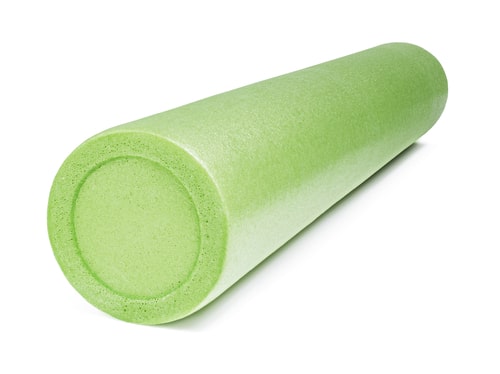 What does a foam roller have to do with fitness? A lot! You may have seen someone rolling back and forth one of these cylindrical objects and wondered what the heck they’re doing. They’re doing a technique called self-myofascial release. It’s a way to help your muscles recover after a workout and reduce the risk of injury.
What does a foam roller have to do with fitness? A lot! You may have seen someone rolling back and forth one of these cylindrical objects and wondered what the heck they’re doing. They’re doing a technique called self-myofascial release. It’s a way to help your muscles recover after a workout and reduce the risk of injury.
Your muscles are covered with a thin layer of dense connective tissue called fascia, the same tissue that covers nerves and blood vessels. Fascia help to hold together and protect groups of muscles while still allowing them to move. The problem is muscle fascia can become too tight, usually as a result of overuse, injury or poor posture. When this happens, it can reduce blood flow to the muscle and cause muscle tension and tightness. That can lead to decreased performance during exercise and a greater risk of injury.
How does fascia become too tight? As you know, the stress of exercise causes microscopic muscle tears to form. This leads to low-grade muscle inflammation. Over time, this inflammation causes scar tissue and adhesions to develop, causing muscle tension and tightness. The goal of myofascial release is to break up this scar tissue, increase blood flow and release tension so the muscle can move fluidly again. Osteopathic physicians and physical therapists perform this technique on clients to help release tight muscles. In fact, the myofascial release has been around for more than 70 years. Fortunately, you can get some of the same benefits at home using a foam roller.
How Does Self-Myofascial Release with a Foam Roller Work?
Self-myofascial release using a foam roller can release tension in almost any muscle group. How do you do it? Position your body over a tight muscle so it’s pressing against the roller. Then use your weight to roll the roller smoothly up and down the muscle. You’re looking for “trigger points,” areas that feel painful when the roller touches them. Once you’ve identified a trigger point, maintain pressure on that point for 30 to 60 seconds before continuing to roll back and forth. Maintaining tension activates neuromuscular receptors that help the muscle relax. Don’t forget to breathe when you’re rolling!
Foam rolling works well for tight hamstrings and quadriceps muscles. Tightness in these muscles can cause your form to be bad when doing squats. It’s also effective for easing the discomfort of iliotibial band syndrome and painful shin splints that increase the risk of injury. Foam rolling the muscles in your back, including the latissimus dorsi and rhomboids, helps to ease the back tightness some people experience after sitting in a chair all day.
Benefits of Self-Myofascial Release
The goal of the self-myofascial release is to break up scar tissue and adhesions and increase blood flow to the muscle. It has other benefits as well. When you release a tight muscle, it eases tension throughout your body. Therefore, it’s a good stress reliever, particularly if you sit a lot during the day. It also reduces the risk of injury by allowing the muscle to move more fluidly. In addition, it’s a good recovery tool to use after a workout.
How to Choose a Foam Roller
Foam rollers have varying degrees of firmness. The least firm is usually white or red in color and apply the least pressure. They have more “give” when you roll a muscle over them, making them less uncomfortable if you’ve never used a roller before. On the downside, they aren’t very durable and won’t hold their shape very long. They’re also usually the least expensive.
Intermediate in firmness are rollers that are usually blue or green in color. They apply a moderate amount of pressure. Black foam rollers are the densest of all and apply very firm pressure. They also hold their shape the best and are the most durable.
Foam rollers usually come in two lengths – 18 inches and 36 inches. The 18 inch has the advantage of being more portable. The advantage of the 36-inch roller is you can lie on it vertically. If you’re ready for maximal pressure, you have another option. Foam rollers with textured nubs break up tough adhesions, but this isn’t a good first foam roller. Start with something less firm. Ultimately, if you use a foam roller a lot, you’ll want to invest in a dense, black form roller. It works best for releasing tough adhesions.
The Bottom Line?
Foam rollers are your best friend when it comes to releasing tight muscles, improving flexibility and increasing range-of-motion without reducing power. Plus, they help you stay free of injuries. Enjoy the benefits they offer!
References:
J Strength Cond Res. 2013 Mar;27(3):812-21.
Related Articles By Cathe:
Does Foam Rolling Really Improve Flexibility?
Does Foam Rolling Reduce Delayed Onset Muscle Soreness?
Is Foam Rolling Good for Your Heart?
What is Fascia and How Does It Impact Your Fitness Training?

